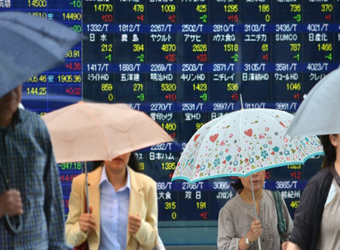The Nikkei 225 fell nearly one percent despite second-quarter Japan GDP surprising to the upside as investors in Asia digested the release of a barrage of China data on Monday.
Japan’s benchmark Nikkei 225 index fell 0.94 percent as markets re-opened after a public holiday last week. Markets appeared to shrug off headlines that the Japanese economy grew at an annualized rate of 4 percent in the second quarter of the year ending in June compared to the previous year. That easily topped the 2.5 percent rise forecast in a Reuters poll.
The yen softened against the dollar following the GDP beat, with the greenback fetching 109.20 yen at 7:52 a.m. HK/SIN compared to levels around 109.14 yen before the data release. The Japanese currency last traded at 109.37 yen to the dollar.
“Although it is usually exactly the wrong thing to respond to volatile Japanese GDP data by revising full year forecasts, arithmetically, it is going to be hard for us to see only the 1.2 percent for 2017 we currently have penciled in,” said ING Asia Head of Research Robert Carnell in a note, adding that an upgrade now seemed “extremely likely.”
Meanwhile, South Korea’s Kospi rose 0.47 percent after being pressured by geopolitical tensions for most of the last week.
In Australia, the S&P/ASX 200 climbed 0.51 percent, with the broader index driven by gains in the information technology and energy sub-indexes. The heavily-weighted financials sub-index was up 0.76 percent.
Greater China markets trended higher even though a raft of data released Monday missed expectations. Hong Kong’s Hang Seng Index gained 0.94 percent. On the mainland, the Shanghai Composite edged up 0.11 percent while the Shenzhen Composite jumped 1.019 percent.
Thailand markets were closed for a public holiday.
Over in the U.S., July consumer prices were weaker than expected, rising just 0.1 percent compared to the month before, Reuters reported on Friday. That was below the 0.2 percent forecast in a Reuters poll.
The CPI rose 1.7 percent compared to the previous year, which was a tad below the 1.8 percent expected. However, the figure remained under the Federal Reserve’s 2 percent inflation target.
The dollar was steady after tumbling on inflation numbers last Friday. The dollar index stood at 93.073 at 10:09 a.m. HK/SIN. The U.S. currency had fallen against a basket of rivals on Friday, trading as low as 92.934 compared to the 93 handle seen for most of last week.
Markets also kept an eye on developments in the Korean peninsula after tensions flared up between the U.S. and North Korea last week. Over the weekend, the hermit state claimed that more than 3 million volunteers had offered to join its army, Reuters said. A U.S. intelligence official said on Sunday that it would not be unexpected for North Korea to test another missile.
In corporate news, Commonwealth Bank of Australia CEO and Managing Director Ian Narev is expected to retire by the end of the 2018 financial year, the bank said on Monday. CBA has recently been dogged by allegations that it potentially ignored breaches in money-laundering regulations in Australia.
In individual stocks, Australia’s Bendigo and Adelaide Bank rose 6.13 percent after the bank reported full-year net profit after tax attributable to owners rose 3.4 percent. Other Australian financials were a mixed picture: with National Australia Bank up 1.19 percent, but AMP off by 0.49 percent.
Meanwhile, shares of Ansell tumbled 3.53 percent after the rubber products manufacturer announced full-year profit fell 7.2 percent and missed estimates, Reuters reported. The company attributed the fall in profit to increasing raw material prices and acquisition charges.
Oil prices were stable after making gains on Friday as markets digested a mix of higher demand forecasts from the IEA and an expected rise in shale production, Reuters reported. Brent crude was off 0.15 percent at $52.02 a barrel and U.S. crude shed 0.04 percent to trade at $48.80.
In currency markets, the Australian dollar, which is usually sensitive to Chinese economic data, was softer after China data released on Monday missed expectations. The Aussie dollar traded at $0.7905 after the data release, compared to levels around $0.7914 seen just before. The Australian currency had traded as high as $0.7919 earlier in the session.
In the U.S., stocks closed slightly higher in the Friday session after being rattled earlier in the week by U.S.-North Korea tensions.
Source: CNBC


